Temporal and Spatial Variations of Extreme Climate Events in Northwestern China from 1960 to 2020
Abstract
:1. Introduction
2. Materials and Methods
2.1. Study Area
2.2. Data Used and the Quality Examination
- Statistical outliers (based on multiples of the inter-quartile range);
- Days where minimum temperature exceeds maximum temperature;
- Unlikely large changes in temperatures between days (when minimum or maximum temperatures change by 20 °C or more);
- More than 10 days with the same (nonzero) precipitation or identical temperatures;
- Uncommonly precipitation and temperature values (precipitation less than zero or greater than 200 mm; temperatures higher than 50 °C).
2.3. Data Analysis
3. Results
3.1. Temperature
3.1.1. Warm Extremes (SU, TR, GSL, TN90p, TX90p, and WSDI)
3.1.2. Cold Extremes (FD, ID, TN10p, TX10p, and CSDI)
3.1.3. Extremal Indices and Diurnal Temperature Range
3.2. Precipitation
4. Discussion and Conclusions
Author Contributions
Funding
Institutional Review Board Statement
Informed Consent Statement
Data Availability Statement
Acknowledgments
Conflicts of Interest
References
- IPCC. Climate Change 2021: The Physical Science Basis. In Contribution of Working Group I to the Sixth Assessment Report of the Intergovernmental Panel on Climate Change; Cambridge University Press: Cambridge, UK, 2021. [Google Scholar]
- Chang, C.J.; Huang, C.P.; Chen, C.Y.; Wang, G.S. Assessing the potential effect of extreme weather on water quality and disinfection by-product formation using laboratory simulation. Water Res. 2020, 170, 115296. [Google Scholar] [CrossRef] [PubMed]
- Deere, D.; Leusch, F.D.L.; Humpage, A.; Cunliffe, D.; Khan, S.J. Hypothetical scenario exercises to improve planning and readiness for drinking water quality management during extreme weather events. Water Res. 2017, 111, 100–108. [Google Scholar] [CrossRef] [PubMed]
- Papalexiou, S.M.; Montanari, A. Global and Regional Increase of Precipitation Extremes Under Global Warming. Water Resour. Res. 2019, 55, 4901–4914. [Google Scholar] [CrossRef]
- Fischer, E.M.; Knutti, R. Anthropogenic contribution to global occurrence of heavy-precipitation and high-temperature extremes. Nat. Clim. Chang. 2015, 5, 560–564. [Google Scholar] [CrossRef]
- Karmalkar, A.V.; Bradley, R.S. Consequences of Global Warming of 1.5 °C and 2 °C for Regional Temperature and Precipitation Changes in the Contiguous United States. PLoS ONE 2017, 12, e0168697. [Google Scholar] [CrossRef]
- Katz, R.W.; Brown, B.G. Extreme Events in a Changing Climate: Variability Is More Important Than Averages. Clim. Change 1992, 21, 289–302. [Google Scholar] [CrossRef]
- Bencze, S.; Balla, K.; Varga, B.; Veisz, O. Effect of climate extremes on the grain yield and quality of cereals. Acta Agron. Hung. 2010, 58, 115–120. [Google Scholar] [CrossRef]
- Kumar, A.; Chen, M.; Hoerling, M.; Eischeid, J. Do extreme climate events require extreme forcings? Geophys. Res. Lett. 2013, 40, 3440–3445. [Google Scholar] [CrossRef]
- Manton, M.J. Trends in climate extremes affecting human settlements. Curr. Opin. Environ. Sustain. 2010, 2, 151–155. [Google Scholar] [CrossRef]
- Wang, X.; Qiu, B.; Li, W.; Zhang, Q. Impacts of drought and heatwave on the terrestrial ecosystem in China as revealed by satellite solar-induced chlorophyll fluorescence. Sci. Total Environ. 2019, 693, 133627. [Google Scholar] [CrossRef]
- Wuebbles, D.; Meehl, G.; Hayhoe, K.; Karl, T.R.; Kunkel, K.; Santer, B.; Wehner, M.; Colle, B.; Fischer, E.M.; Fu, R.; et al. CMIP5 Climate Model Analyses: Climate Extremes in the United States. Bull. Am. Meteorol. Soc. 2014, 95, 571–583. [Google Scholar] [CrossRef]
- Yang, J.; Yin, P.; Sun, J.; Wang, B.; Zhou, M.; Li, M.; Tong, S.; Meng, B.; Guo, Y.; Liu, Q. Heatwave and mortality in 31 major Chinese cities: Definition, vulnerability and implications. Sci. Total Environ. 2019, 649, 695–702. [Google Scholar] [CrossRef] [PubMed]
- Hu, J.; Yang, Z.; Hou, C.; Ouyang, W. Compound risk dynamics of drought by extreme precipitation and temperature events in a semi-arid watershed. Atmos. Res. 2023, 281, 1064774. [Google Scholar] [CrossRef]
- Robinson, W.A. Climate change and extreme weather: A review focusing on the continental United States. J. Air Waste Manag. Assoc. 2021, 71, 1186–1209. [Google Scholar] [CrossRef] [PubMed]
- Song, M.; Pei, Y.; Zhang, S.; Wu, T. Simulation Performance and Case Study of Extreme Events in Northwest China Using the BCC-CSM2 Model. Remote Sens. 2022, 14, 4922. [Google Scholar] [CrossRef]
- Thomas, T.S.; Schlosser, C.A.; Strzepek, K.; Robertson, R.D.; Arndt, C. Using a Large Climate Ensemble to Assess the Frequency and Intensity of Future Extreme Climate Events in Southern Africa. Front. Clim. 2022, 4, 787721. [Google Scholar] [CrossRef]
- Lucas, E.W.M.; Sousa, F.d.A.S.d.; Silva, F.D.d.S.; Rocha Júnior, R.L.d.; Pinto, D.D.C.; Silva, V.d.P.R.d. Trends in climate extreme indices assessed in the Xingu river basin—Brazilian Amazon. Weather Clim. Extrem. 2021, 31, 100306. [Google Scholar] [CrossRef]
- McGree, S.; Herold, N.; Alexander, L.; Schreider, S.; Kuleshov, Y.; Ene, E.; Finaulahi, S.; Inape, K.; Mackenzie, B.; Malala, H.; et al. Recent Changes in Mean and Extreme Temperature and Precipitation in the Western Pacific Islands. J. Clim. 2019, 32, 4919–4941. [Google Scholar] [CrossRef]
- Fan, Y.; Li, J.; Zhu, S.; Li, H.; Zhou, B. Trends and variabilities of precipitation and temperature extremes over Southeast Asia during 1981–2017. Meteorol. Atmos. Phys. 2022, 134, 78. [Google Scholar] [CrossRef]
- Xu, Z.; Chang, A.; Di Vittorio, A. Evaluating and projecting of climate extremes using a variable-resolution global climate model (VR-CESM). Weather Clim. Extrem. 2022, 38, 100496. [Google Scholar] [CrossRef]
- Coumou, D.; Rahmstorf, S. A decade of weather extremes. Nat. Clim. Change 2012, 2, 491–496. [Google Scholar] [CrossRef]
- Alexander, L.V.; Zhang, X.; Peterson, T.C.; Caesar, J.; Gleason, B.; Klein Tank, A.M.G.; Haylock, M.; Collins, D.; Trewin, B.; Rahimzadeh, F.; et al. Global observed changes in daily climate extremes of temperature and precipitation. J. Geophys. Res. Atmos. 2006, 111, D05109. [Google Scholar] [CrossRef]
- Frich, P.; Alexander, L.; Della-Marta, P.; Gleason, B.; Haylock, M.; Klein Tank, A.; Peterson, T. Observed coherent changes in climatic extremes during the second half of the twentieth century. Clim. Res. 2002, 19, 193–212. [Google Scholar] [CrossRef]
- Zhai, P.; Ren, F. On changes of China’s maximum and minimum temperatures in 1951–1990. Acta Meteorol. Sin. 1999, 13, 278–290. [Google Scholar]
- Chen, H.; Sun, J. Changes in climate extreme events in China associated with warming. Int. J. Climatol. 2015, 35, 2735–2751. [Google Scholar] [CrossRef]
- Yu, X.; Ma, Y. Spatial and Temporal Analysis of Extreme Climate Events over Northeast China. Atmosphere 2022, 13, 1197. [Google Scholar] [CrossRef]
- Liu, W.; Fu, Z.; Chen, X.; Qu, J.; Wang, J.; Peng, X. Inhomogeneity of precipitation and its influencing factors in Northwest China from 1961 to 2015. Theor. Appl. Climatol. 2019, 138, 1831–1844. [Google Scholar] [CrossRef]
- Wang, H.; Gao, T.; Xie, L. Extreme precipitation events during 1960–2011 for the Northwest China: Space-time changes and possible causes. Theor. Appl. Climatol. 2018, 137, 977–995. [Google Scholar] [CrossRef]
- Zhong, Y.; Yang, M.; Yuan, C. Temporal and Spatial Characteristics of Summer Extreme Precipitation in Eastern China and Possible Causalities. J. Geosci. Environ. Prot. 2020, 8, 36–46. [Google Scholar] [CrossRef]
- Gao, J.; Jiao, K.; Wu, S. Quantitative assessment of ecosystem vulnerability to climate change: Methodology and application in China. Environ. Res. Lett. 2018, 13, 094016. [Google Scholar] [CrossRef]
- Li, B.; Chen, Y.; Shi, X. Why does the temperature rise faster in the arid region of northwest China? J. Geophys. Res. Atmos. 2012, 117, D16115. [Google Scholar] [CrossRef]
- Yang, P.; Xia, J.; Zhang, Y.; Hong, S. Temporal and spatial variations of precipitation in Northwest China during 1960–2013. Atmos. Res. 2017, 183, 283–295. [Google Scholar] [CrossRef]
- Shi, Y.; Shen, Y.; Kang, E.; Li, D.; Ding, Y.; Zhang, G.; Hu, R. Recent and Future Climate Change in Northwest China. Clim. Change 2007, 80, 379–393. [Google Scholar] [CrossRef]
- Lu, S.; Hu, Z.; Yu, H.; Fan, W.; Fu, C.; Wu, D. Changes of Extreme Precipitation and its Associated Mechanisms in Northwest China. Adv. Atmos. Sci. 2021, 38, 1665–1681. [Google Scholar] [CrossRef]
- Wang, H.; Chen, Y.; Chen, Z. Spatial distribution and temporal trends of mean precipitation and extremes in the arid region, northwest of China, during 1960–2010. Hydrol. Process. 2013, 27, 1807–1818. [Google Scholar] [CrossRef]
- Wu, P.; Ding, Y.; Liu, Y.; Li, X. The characteristics of moisture recycling and its impact on regional precipitation against the background of climate warming over Northwest China. Int. J. Climatol. 2019, 39, 5241–5255. [Google Scholar] [CrossRef]
- Liu, C.; Chen, Y.; Xu, Z. Eco-hydrology and sustainable development in the arid regions of China. Hydrol. Process. 2009, 24, 127–128. [Google Scholar] [CrossRef]
- Zheng, J.; Bian, J.; Ge, Q.; Yin, Y. The climate regionalization in China for 1951–1980 and 1981–2010. Geogr. Res. 2020, 32, 987–997. (In Chinese) [Google Scholar]
- Liu, X.; Ren, Z. Progress in quality control of surface meteorological data. Meteorogical Sci. Technol. 2005, 33, 199–203. (In Chinese) [Google Scholar]
- Haylock, M.R.; Hofstra, N.; Klein Tank, A.M.G.; Klok, E.J.; Jones, P.D.; New, M. A European daily high-resolution gridded data set of surface temperature and precipitation for 1950–2006. J. Geophys. Res. 2008, 113, D20119. [Google Scholar] [CrossRef]
- Menne, M.J.; Durre, I.; Vose, R.S.; Gleason, B.E.; Houston, T.G. An Overview of the Global Historical Climatology Network-Daily Database. J. Atmos. Ocean. Technol. 2012, 29, 897–910. [Google Scholar] [CrossRef]
- Dunn, R.J.H.; Alexander, L.V.; Donat, M.G.; Zhang, X.; Bador, M.; Herold, N.; Barry, A.A. Development of an updated global land in-situ-based dataset of temperature and precipitation extremes: HadEX3. J. Geophys. Res. Atmos. 2020, 125, e2019JD032263. [Google Scholar] [CrossRef]
- Zhang, X.; Alexander, L.; Hegerl, G.C.; Jones, P.; Tank, A.K.; Peterson, T.C.; Trewin, B.; Zwiers, F.W. Indices for monitoring changes in extremes based on daily temperature and precipitation data. WIREs Clim. Change 2011, 2, 851–870. [Google Scholar] [CrossRef]
- Yan, Z.; Jones, P.D.; Davies, T.D.; Moberg, A.; Bergström, H.; Camuffo, D.; Yang, C. Trends of Extreme Temperatures in Europe and China Based on Daily Observations. Clim. Change 2002, 53, 355–392. [Google Scholar] [CrossRef]
- Klein Tank, A.M.G.; Wijngaard, J.B.; Können, G.P.; Böhm, R.; Demarée, G.; Gocheva, A.; Petrovic, P. Daily dataset of 20th-century surface air temperature and precipitation series for the European Climate Assessment. Int. J. Climatol. 2002, 22, 1441–1453. [Google Scholar] [CrossRef]
- Vincent, L.A.; Mekis, É. Changes in Daily and Extreme Temperature and Precipitation Indices for Canada over the Twentieth Century. Atmos.-Ocean 2006, 44, 177–193. [Google Scholar] [CrossRef]
- Zhang, X.; Hegerl, G.; Zwiers, F.W.; Kenyon, J. Avoiding Inhomogeneity in Percentile-Based Indices of Temperature Extremes. J. Clim. 2005, 18, 1641–1651. [Google Scholar] [CrossRef]
- Niu, T.; Chen, L.X.; Zhou, Z.J. The characteristics of climate change over the Tibetan Plateau in the last 40 years and the detection of climatic jumps. Adv. Atmos. Sci. 2004, 21, 193–203. [Google Scholar] [CrossRef]
- Deng, H.; Chen, Y.; Shi, X.; Li, W.; Wang, H.; Zhang, S.; Fang, G. Dynamics of temperature and precipitation extremes and their spatial variation in the arid region of northwest China. Atmos. Res. 2014, 138, 346–355. [Google Scholar] [CrossRef]
- Qi, Y.; Chen, H.Y.; Fang, S.B.; Yu, W.G. Variation Characteristics of Extreme Climate Events in Northwest China During 1961–2010. J. Arid. Meteorol. 2015, 33, 963–969. [Google Scholar]
- Wang, B.L.; Zhang, M.J.; Wei, J.L.; Wang, S.J.; Ma, Q.; Li, X.F. The Change in Extreme Events of Temperature and Precipitation over Northwest China in Recent 50 Year. J. Nat. Resour. 2012, 27, 1720–1733. [Google Scholar] [CrossRef]
- Wang, H.; Chen, Y.; Xun, S.; Lai, D.; Fan, Y.; Li, Z. Changes in daily climate extremes in the arid area of northwestern China. Theor. Appl. Climatol. 2012, 112, 15–28. [Google Scholar] [CrossRef]
- Horton, D.E.; Johnson, N.C.; Singh, D.; Swain, D.L.; Rajaratnam, B.; Diffenbaugh, N.S. Contribution of changes in atmospheric circulation patterns to extreme temperature trends. Nature 2015, 522, 465–469. [Google Scholar] [CrossRef] [PubMed]
- Zhang, G.; Zeng, G.; Li, C.; Yang, X. Impact of PDO and AMO on interdecadal variability in extreme high temperatures in North China over the most recent 40-year period. Clim. Dynam. 2020, 54, 3003–3020. [Google Scholar] [CrossRef]
- He, Z.; Du, J.; Zhao, W.; Yang, J.; Chen, L.; Zhu, X.; Chang, X.; Liu, H. Assessing temperature sensitivity of subalpine shrub phenology in semi-arid mountain regions of China. Agricult. For. Meteorol. 2015, 213, 42–52. [Google Scholar] [CrossRef]
- McMillan, A.M.S.; Winston, G.C.; Goulden, M.L. Age-dependent response of boreal forest to temperature and rainfall variability. Glob. Change Biol. 2008, 14, 1904–1916. [Google Scholar] [CrossRef]
- Dai, A.; Trenberth, K.E.; Karl, T.R. Effects of Clouds, Soil Moisture, Precipitation, and Water Vapor on Diurnal Temperature Range. J. Clim. 1999, 12, 2451–2473. [Google Scholar] [CrossRef]
- Feng, J.M.; Wang, Y.L.; Ma, Z.G.; Liu, Y.H. Simulating the Regional Impacts of Urbanization and Anthropogenic Heat Release on Climate across China. J. Clim. 2012, 25, 7187–7203. [Google Scholar] [CrossRef]
- Kaiser, D.P. Decreasing cloudiness over China: An updated analysis examining additional variables. Geophys. Res. Lett. 2000, 27, 2193–2196. [Google Scholar] [CrossRef]
- Liu, B.; Xu, M.; Henderson, M.; Qi, Y.; Li, Y. Taking China’s Temperature: Daily Range, Warming Trends, and Regional Variations, 1955–2000. J. Clim. 2004, 17, 4453–4462. [Google Scholar] [CrossRef]
- Wang, L.; Liu, B.; Henderson, M.; Shen, X.; Yang, L.; Lian, L. Warming across decades and deciles: Minimum and maximum daily temperatures in China, 1955–2014. Int. J. Climatol. 2017, 38, 2325–2332. [Google Scholar] [CrossRef]
- Gong, Z.; Wang, X.; Zhi, R.; Feng, G. Regional characteristics of temperature changes in China during the past 58 years and its probable correlation with abrupt temperature change. Acta Phys. Sin. 2009, 58, 4342–4353. [Google Scholar] [CrossRef]
- Wang, H.; Chen, Y.; Li, W.; Deng, H. Runoff responses to climate change in arid region of northwestern China during 1960–2010. Chin. Geogra. Sci. 2013, 23, 286–300. [Google Scholar] [CrossRef]
- Sun, G.; Chen, Y.; Li, W. Interannual and Interdecadal Variations of Extreme Hydrological Events and Response to Climate Change in Xinjiang. Sci. Geogr. Sin. 2011, 31, 1389–1395. [Google Scholar] [CrossRef]
- Xu, C.; Chen, Y.; Yang, Y.; Hao, X.; Shen, Y. Hydrology and water resources variation and its response to regional climate change in Xinjiang. J. Geogr. Sci. 2010, 20, 599–612. [Google Scholar] [CrossRef]
- Deng, H.; Tang, Q.; Yun, X.; Tang, Y.; Liu, X.; Xu, X.; Sun, S.; Zhao, G.; Zhang, Y.; Zhang, Y. Wetting trend in Northwest China reversed by warmer temperature and drier air. J. Hydrol. 2022, 613, 128435. [Google Scholar] [CrossRef]
- Qian, W.H.; Qin, A. Precipitation division and climate shift in China from 1960 to 2000. Theor. Appl. Climatol. 2007, 93, 1–17. [Google Scholar] [CrossRef]
- Wang, H.J. The Weakening of the Asian Monsoon Circulation after the End of 1970’s. Adv. Atmos. Sci. 2001, 18, 376–386. [Google Scholar] [CrossRef]
- Li, B.; Chen, Y.; Chen, Z.; Xiong, H.; Lian, L. Why does precipitation in northwest China show a significant increasing trend from 1960 to 2010? Atmos. Res. 2016, 167, 275–284. [Google Scholar] [CrossRef]
- Liu, Z.; Menzel, L.; Dong, C.; Fang, R. Temporal dynamics and spatial patterns of drought and the relation to ENSO: A case study in Northwest China. Int. J. Climatol. 2016, 36, 2886–2898. [Google Scholar] [CrossRef]
- Peng, D.; Zhou, T. Why was the arid and semiarid northwest China getting wetter in the recent decades? J. Geophys. Res. Atmos. 2017, 122, 9060–9075. [Google Scholar] [CrossRef]
- Zhou, B.; Xu, Y.; Wu, J.; Dong, S.; Shi, Y. Changes in temperature and precipitation extreme indices over China: Analysis of a high-resolution grid dataset. Int. J. Climatol. 2016, 36, 1051–1066. [Google Scholar] [CrossRef]
- Beniston, M.; Stephenson, D.B. Extreme climatic events and their evolution under changing climatic conditions. Glob. Planet. Change 2004, 44, 1–9. [Google Scholar] [CrossRef]
- Cao, L.; Zhu, Y.; Tang, G.; Yuan, F.; Yan, Z. Climatic warming in China according to a homogenized data set from 2419 stations. Int. J. Climatol. 2016, 36, 4384–4392. [Google Scholar] [CrossRef]
- Bertrand, C.; Ingels, R.; Journée, M. Homogenization and trends analysis of the Belgian historical precipitation time series. Int. J. Climatol. 2021, 41, 5277–5294. [Google Scholar] [CrossRef]
- Jiang, S.; Wang, K.; Mao, Y. Rapid Local Urbanization around Most Meteorological Stations Explains the Observed Daily Asymmetric Warming Rates across China from 1985 to 2017. J. Clim. 2020, 33, 9045–9061. [Google Scholar] [CrossRef]
- Li, Q.; Dong, W.; Jones, P. Continental scale surface air temperature variations: Experience derived from the Chinese region. Earth-Sci. Rev. 2020, 200, 102998. [Google Scholar] [CrossRef]
- Zhang, Y.; Ren, Y.; Ren, G.; Wang, G. Precipitation Trends Over Mainland China from 1961–2016 after Removal of Measurement Biases. J. Geophys. Res. Atmos. 2020, 125, e2019JD031728. [Google Scholar] [CrossRef]
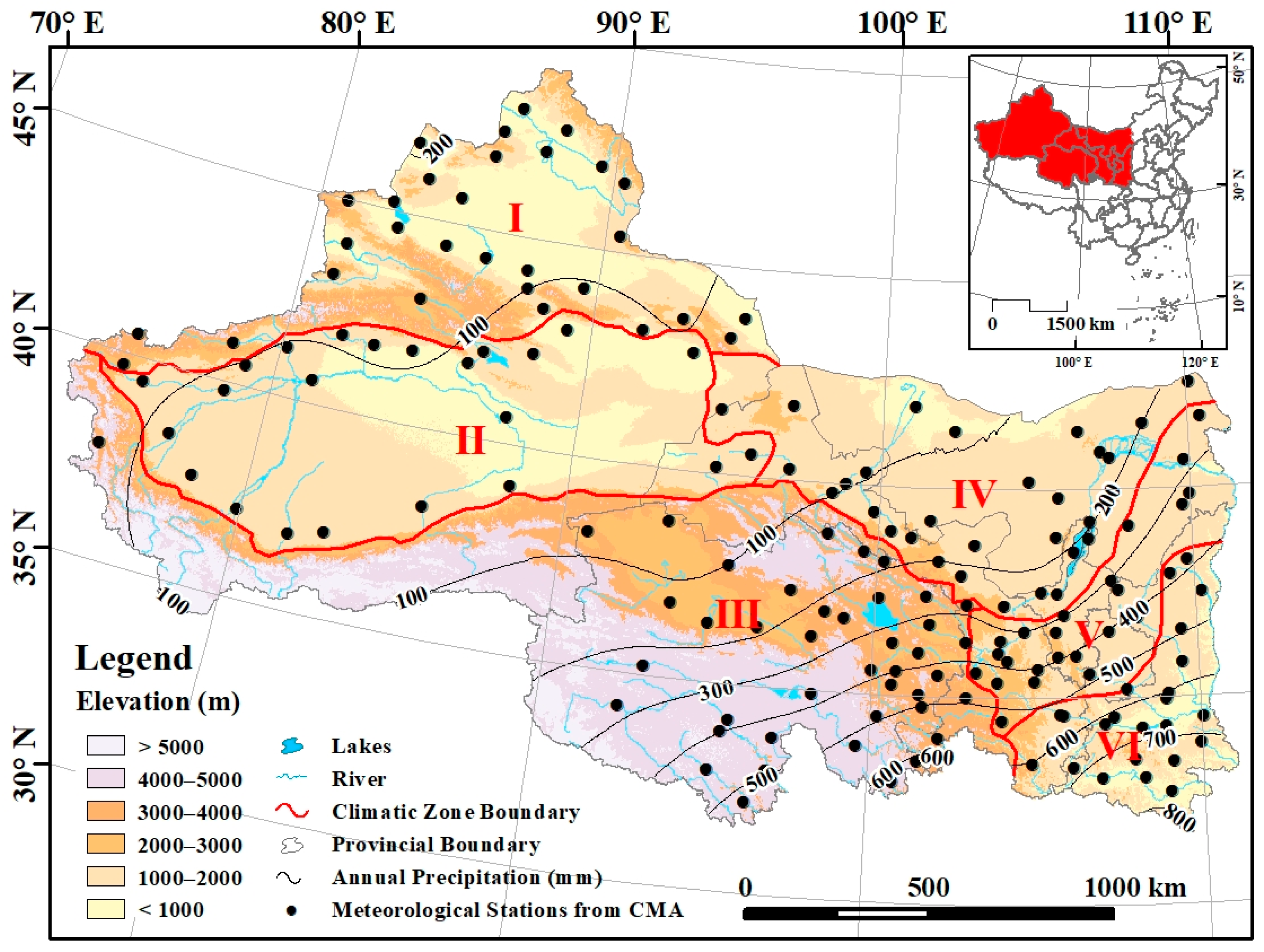

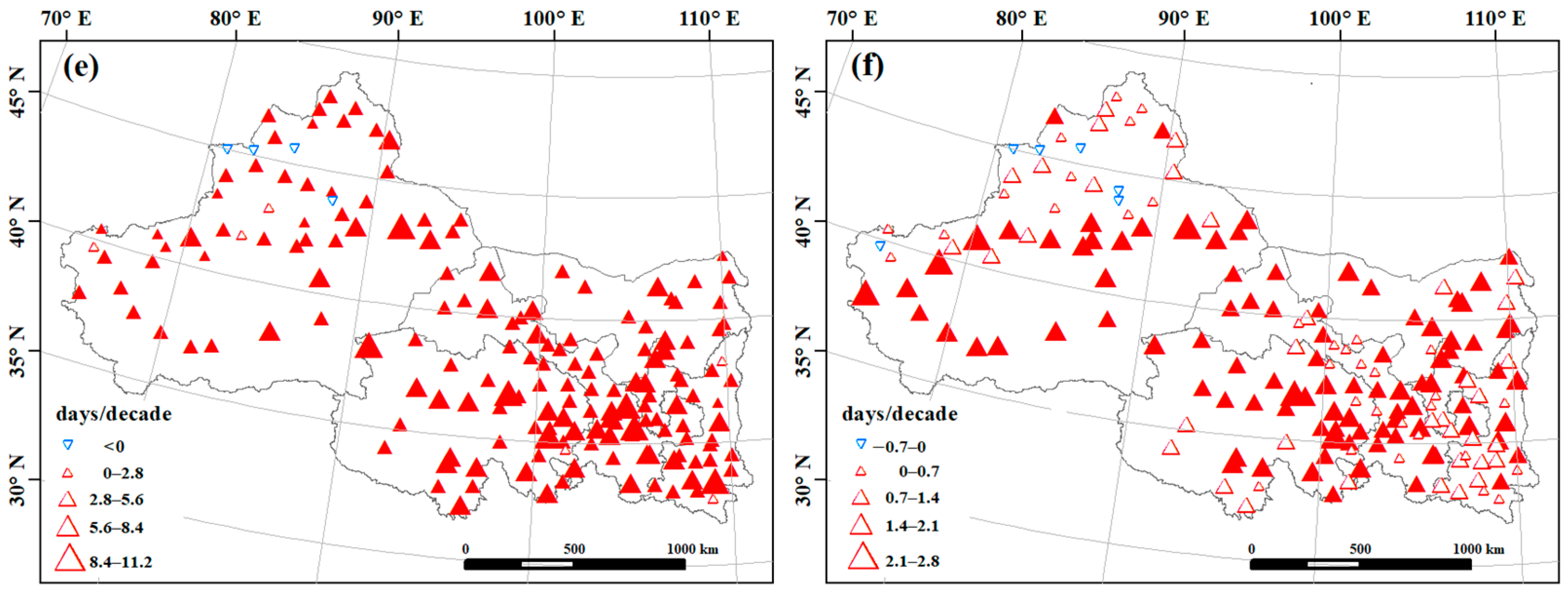

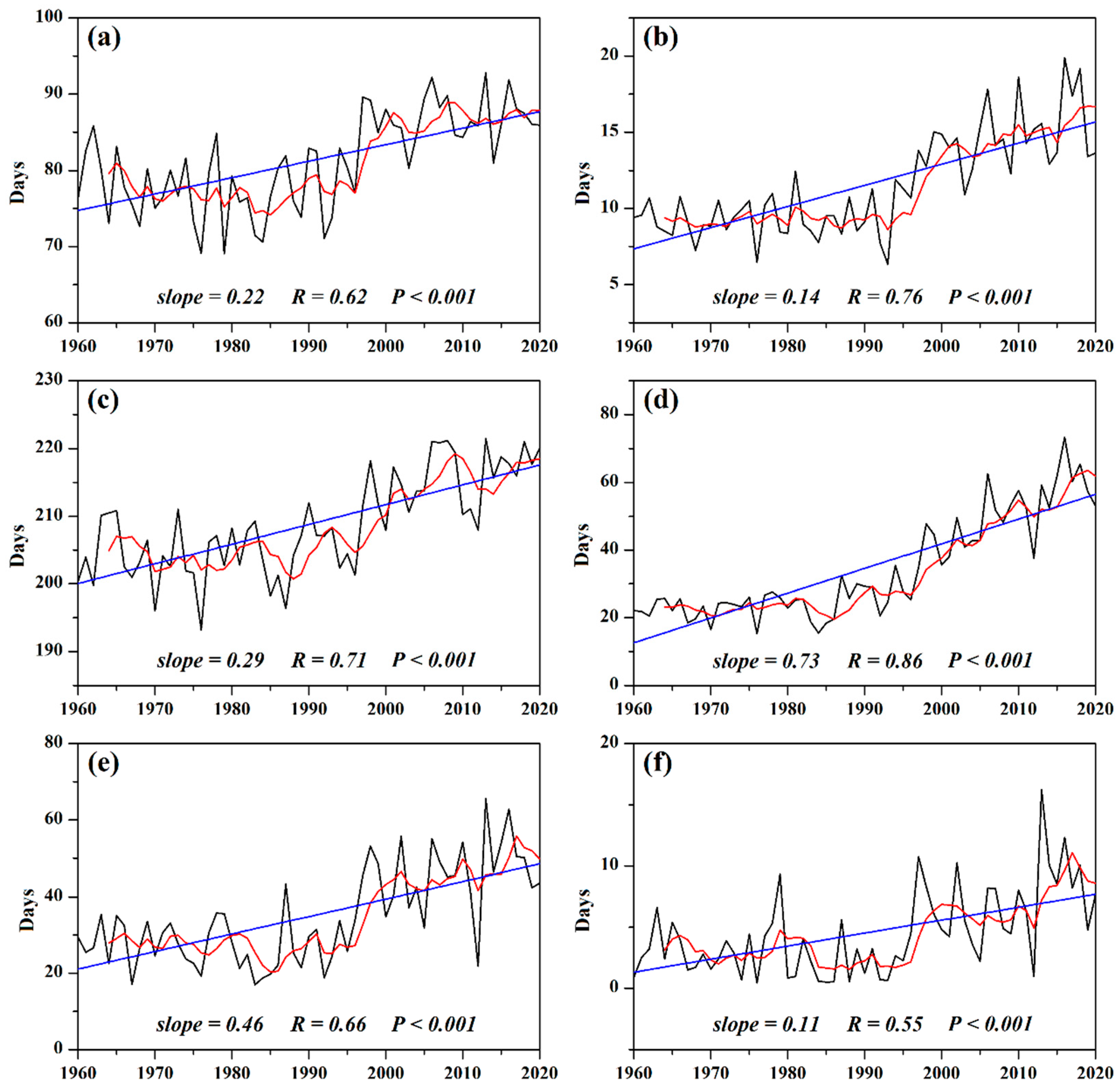




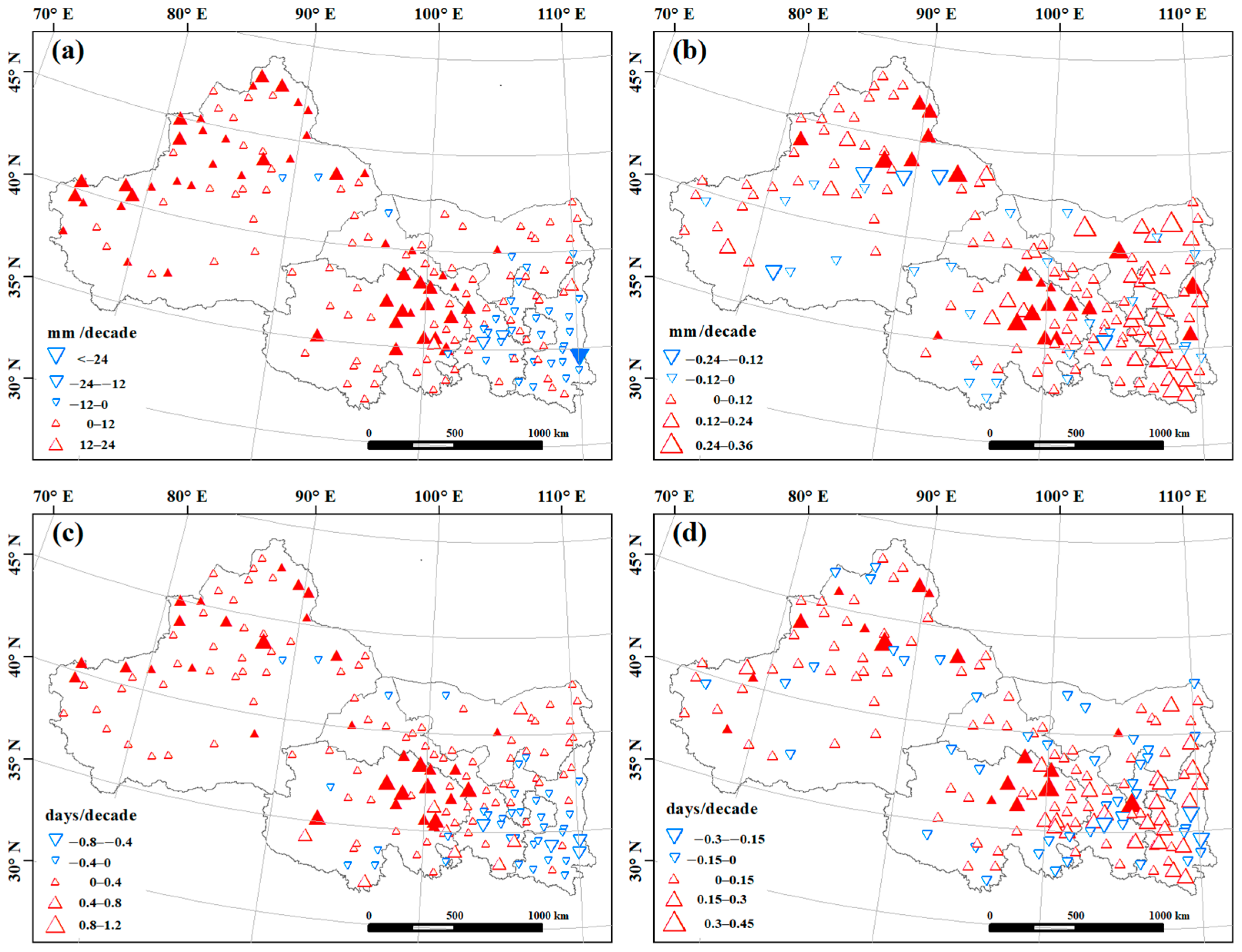
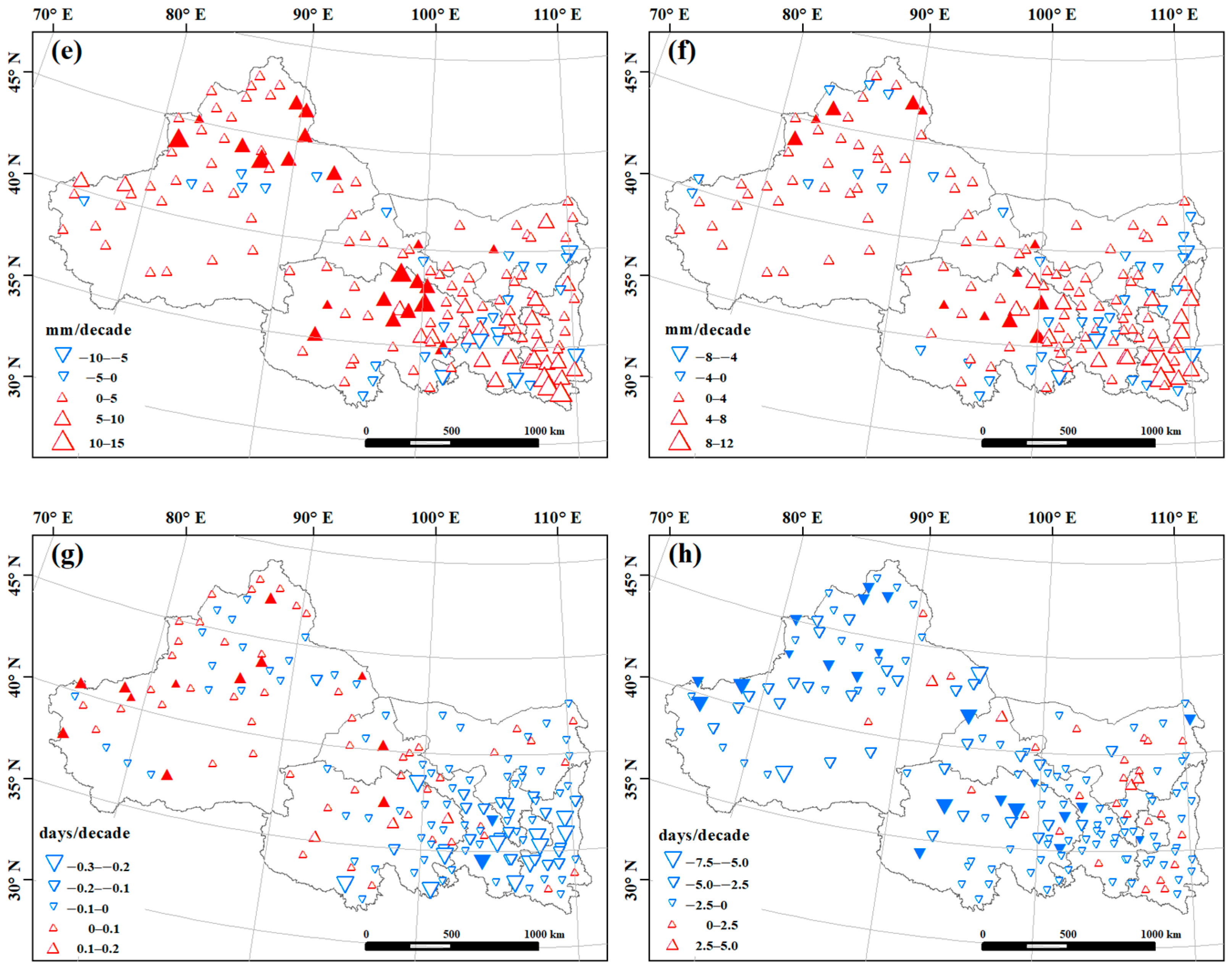
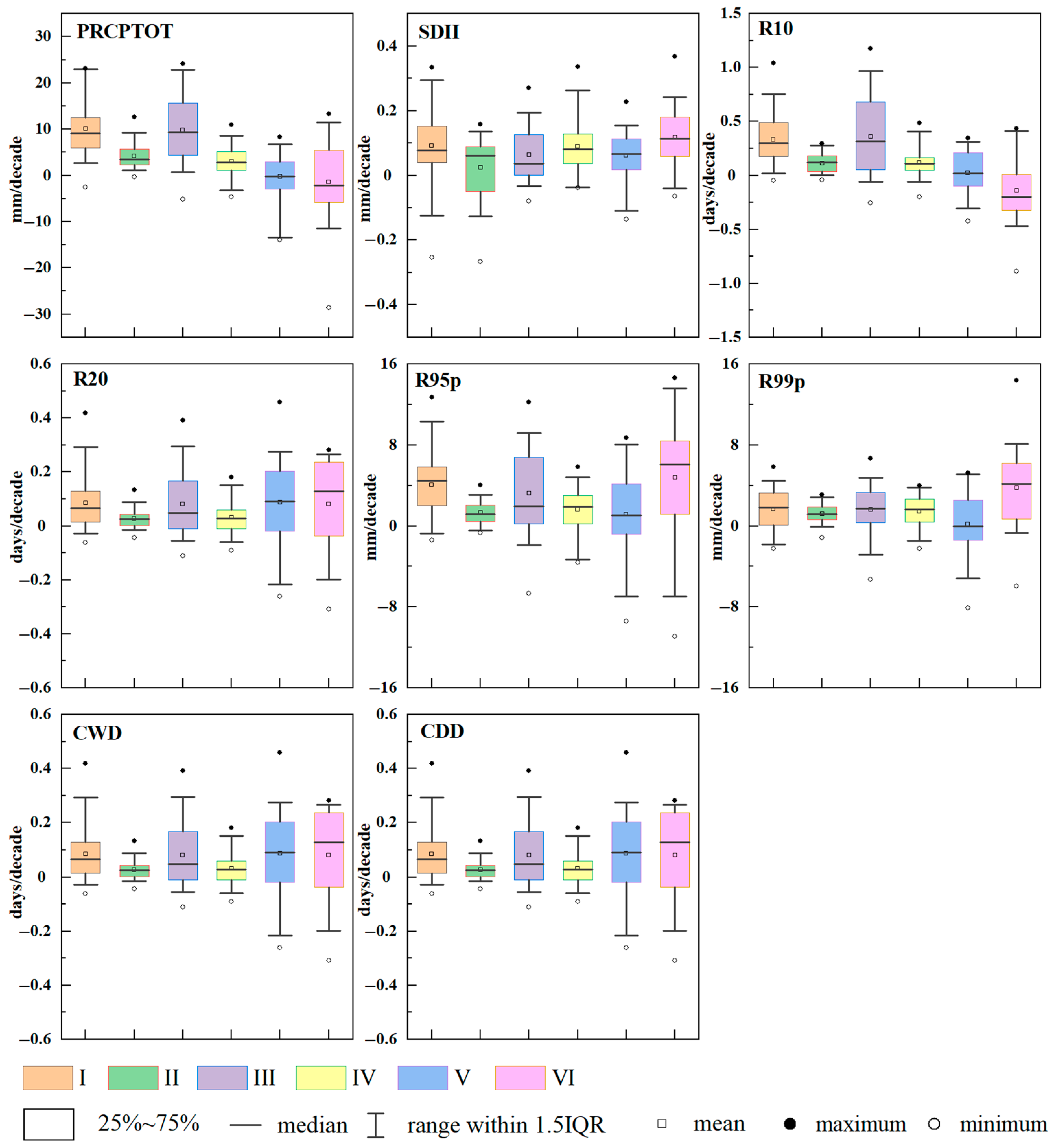
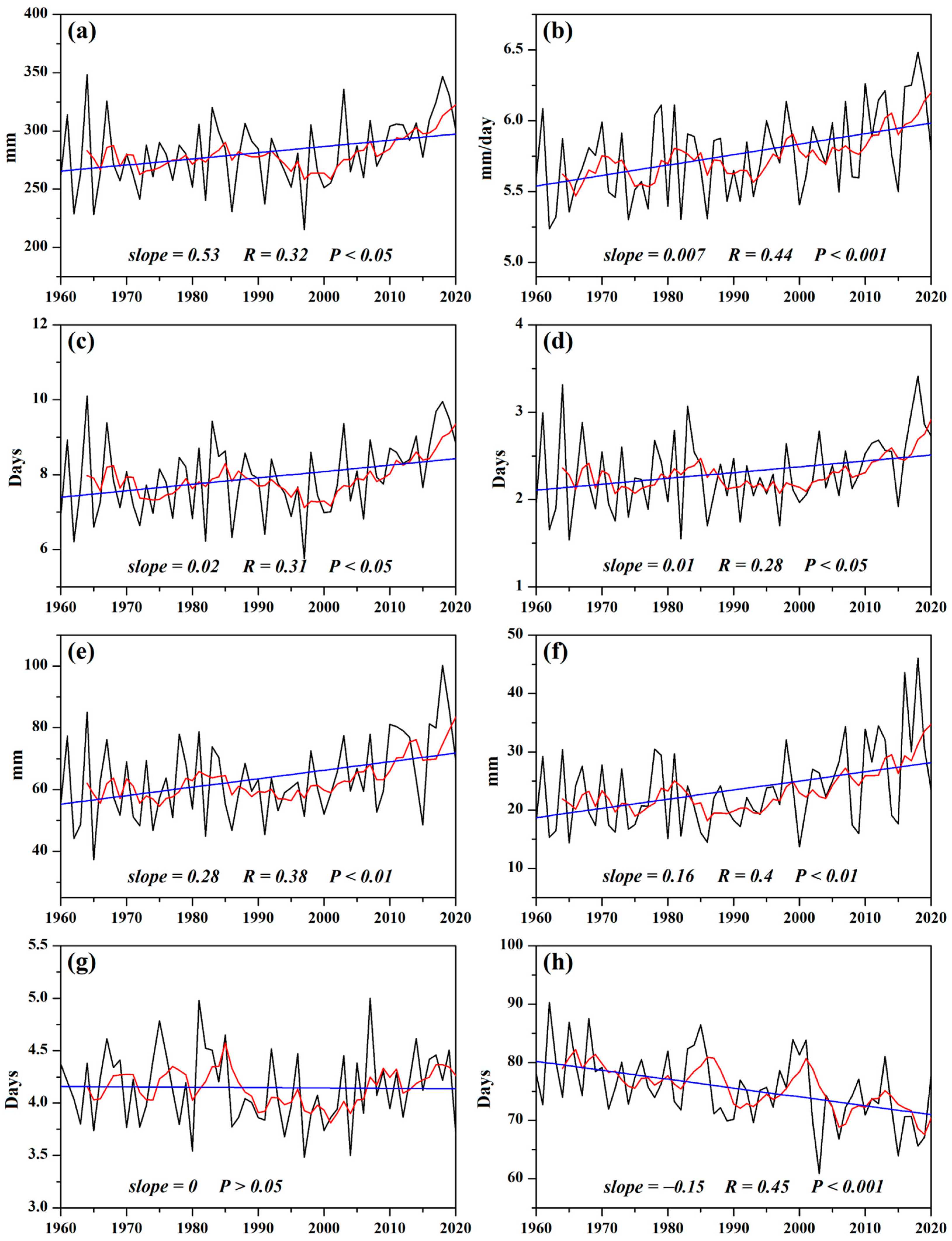
| Index | Indicator Name | Definitions | Unit |
|---|---|---|---|
| TXx | max TX | Monthly maximum value of TX | °C |
| TNx | max TN | Monthly maximum value of TN | °C |
| TXn | min TX | Monthly minimum value of TX | °C |
| TNn | min TN | Monthly minimum value of TN | °C |
| FD | frost days | Annual count of days when TN < 0 °C | days |
| SU | summer days | Annual count of days when TX > 25 °C | days |
| ID | icing days | Annual count of days when TX < 0 °C | days |
| TR | tropical nights | Annual count of days when TN > 20 °C | days |
| GSL | growing season length | Annual count between the first span of at least 6 days with daily mean temperature TG > 5 °C and first span after July 1st of 6 days with TG < 5 °C | days |
| TN10p | cool nights | Percentage of days when TN < 10th percentile | days |
| TX10p | cool days | Percentage of days when TX < 10th percentile | days |
| TN90p | warm nights | Percentage of days when TN > 90th percentile | days |
| TX90p | warm days | Percentage of days when TX > 90th percentile | days |
| WSDI | warm spell duration index | Annual count of days with at least 6 consecutive days when TX > 90th percentile | days |
| CSDI | cold spell duration index | Annual count of days with at least 6 consecutive days when TN < 10th percentile | days |
| DTR | daily temperature range | Monthly mean difference between TX and TN | °C |
| Index | Indicator Name | Definitions | Unit |
|---|---|---|---|
| R10mm | number of heavy precipitation days | Annual count of days when RR ≥ 10 mm | days |
| R20mm | number of very heavy precipitation days | Annual count of days when RR ≥ 20 mm | days |
| R95pTOT | very wet days | Annual total PRCP when RR > 95th percentile | mm |
| R99pTOT | extremely wet days | Annual total PRCP when RR > 99th percentile | mm |
| CDD | consecutive dry days | Maximum length of dry spell, maximum number of consecutive days with RR < 1 mm | days |
| CWD | consecutive wet days | Maximum length of a wet spell, maximum number of consecutive days with RR ≥ 1 mm | days |
| RX1day | max 1-day precipitation amount | Monthly maximum 1-day precipitation | mm |
| RX5day | max 5-day precipitation amount | Monthly maximum consecutive 5-day precipitation | mm |
| SDII | simple daily intensity index | Annual total precipitation divided by the number of wet days (defined as precipitation ≥ 1.0 mm) in the year | mm/day |
| PRCPTOT | annual total wet-day precipitation | Annual total precipitation in wet days with RR ≥ 1.0 mm | mm |
| Index | Negative | Nonsignificant | Positive | |
|---|---|---|---|---|
| Warm Indices | SU | 0.6 (1.8) | 20.4 | 79 (98.2) |
| TR | 1.5 (5.2) | 20.1 | 78.4 (94.8) | |
| GSL | 0 (0.6) | 18.1 | 81.9 (99.4) | |
| TN90p | 0.6 (1.2) | 2.3 | 97.1 (98.8) | |
| TX90p | 0 (2.3) | 5.8 | 94.2 (97.7) | |
| WSDI | 0 (3.5) | 44.2 | 55.8 (96.5) | |
| Cold Indices | FD | 93.6 (98.3) | 5.8 | 0.6 (1.7) |
| ID | 58.1 (95.9) | 41.9 | 0 (4.1) | |
| TN10p | 95.3 (97.7) | 4.1 | 0.6 (2.3) | |
| TX10p | 95.3 (99.4) | 4.7 | 0 (0.6) | |
| CSDI | 50.6 (98.8) | 49.4 | 0 (1.2) | |
| Wet Indices | PRCPTOT | 0.6 (20.3) | 70.9 | 28.5 (79.7) |
| SDII | 0 (18.0) | 87.8 | 12.2 (82.0) | |
| R10mm | 0 (22.7) | 81.4 | 18.6 (77.3) | |
| R20mm | 0 (28.1) | 90.1 | 9.9 (71.9) | |
| R95pTOT | 0 (18.5) | 87.5 | 12.5 (81.5) | |
| R99pTOT | 0 (23.8) | 92.9 | 7.1 (76.2) | |
| CWD | 1.2 (47.1) | 91.8 | 7.0 (52.9) | |
| Dry Indices | CDD | 12.8 (83.1) | 87.2 | 0 (16.9) |
| Indices (Unit) | The Whole Zone | Zone I | Zone II | Zone III | Zone IV | Zone V | Zone VI |
|---|---|---|---|---|---|---|---|
| SU (days) | 81 | 86 | 151 | 13 | 104 | 72 | 108 |
| TR (days) | 11.5 | 13 | 24 | 0 | 9 | 3 | 31 |
| GSL (days) | 207 | 199 | 242 | 156 | 214 | 215 | 264 |
| TN90p (days) | 35 | 33 | 35 | 36 | 34 | 34 | 36 |
| TX90p (days) | 35 | 35 | 34 | 35 | 35 | 35 | 36 |
| WSDI (days) | 5 | 5 | 6 | 4 | 4 | 4 | 5 |
| FD (days) | 166 | 172 | 137 | 226 | 164 | 154 | 94 |
| ID (days) | 52 | 93 | 35 | 61 | 51 | 40 | 15 |
| TN10p (days) | 43 | 45 | 44 | 43 | 44 | 43 | 40 |
| TX10p (days) | 39 | 39 | 39 | 38 | 39 | 39 | 37 |
| CSDI (days) | 6 | 7 | 10 | 4 | 6 | 5 | 5 |
| PRCPTOT (mm) | 281.8 | 178.5 | 51.2 | 347.3 | 126.9 | 380.4 | 624.8 |
| SDII (mm/day) | 5.8 | 4.5 | 4.4 | 5.1 | 5.3 | 7.2 | 9.1 |
| R10mm (days) | 8 | 4 | 1 | 9 | 3 | 12 | 19 |
| R20mm (days) | 2 | 1 | 0 | 2 | 1 | 4 | 8 |
| R95pTOT (mm) | 63.7 | 36.8 | 11.8 | 68.7 | 29.3 | 91.4 | 156.8 |
| R99pTOT (mm) | 23.5 | 14.6 | 9.8 | 21.1 | 17.7 | 33.6 | 50.2 |
| CWD (days) | 4 | 3 | 2 | 6 | 3 | 4 | 6 |
| CDD (days) | 76 | 63 | 126 | 74 | 92 | 57 | 43 |
| January | February | March | April | May | June | July | August | September | October | November | December | |
|---|---|---|---|---|---|---|---|---|---|---|---|---|
| TXx | 0.3 | 0.4 ** | 0.5 ** | 0.3 * | 0.2 * | 0.1 | 0.3 ** | 0.1 | 0.3 ** | 0.3 ** | 0.4 ** | 0.2 |
| TNx | 0.3 ** | 0.6 ** | 0.5 ** | 0.4 ** | 0.3 ** | 0.4 ** | 0.3 ** | 0.2 ** | 0.4 ** | 0.3 ** | 0.4 ** | 0.4 ** |
| TXn | 0.1 | 0.4 * | 0.3 * | 0.4 * | 0.1 | 0.1 | 0.2 | 0.1 | 0.3 ** | 0.3 * | 0.4 | 0.4 |
| TNn | 0.4 ** | 0.6 ** | 0.5 ** | 0.6 ** | 0.3 ** | 0.5 ** | 0.4 ** | 0.4 ** | 0.5 ** | 0.5 ** | 0.6 ** | 0.5 ** |
| DTR | −0.3 ** | −0.2 * | −0.1 | −0.1 | −0.1 | −0.3 ** | −0.1 ** | −0.2 ** | −0.1 * | −0.1 | −0.1 | −0.2 ** |
| January | February | March | April | May | June | July | August | September | October | November | December | |
|---|---|---|---|---|---|---|---|---|---|---|---|---|
| RX1day | 0.1 ** | 0.2 ** | 0 | 0.1 | 0.3 | 0.8 ** | 0.4 | 0.2 | 0.1 | 0 | 0 | 0.1 * |
| RX5day | 0.2 ** | 0.2 ** | 0 | 0 | 0.4 | 1.4 ** | 0.4 | 0.3 | 0 | −0.1 | 0.1 | 0.1 |
Disclaimer/Publisher’s Note: The statements, opinions and data contained in all publications are solely those of the individual author(s) and contributor(s) and not of MDPI and/or the editor(s). MDPI and/or the editor(s) disclaim responsibility for any injury to people or property resulting from any ideas, methods, instructions or products referred to in the content. |
© 2023 by the authors. Licensee MDPI, Basel, Switzerland. This article is an open access article distributed under the terms and conditions of the Creative Commons Attribution (CC BY) license (https://creativecommons.org/licenses/by/4.0/).
Share and Cite
Liang, X.; Niu, Z.; Li, X. Temporal and Spatial Variations of Extreme Climate Events in Northwestern China from 1960 to 2020. Sustainability 2023, 15, 14882. https://doi.org/10.3390/su152014882
Liang X, Niu Z, Li X. Temporal and Spatial Variations of Extreme Climate Events in Northwestern China from 1960 to 2020. Sustainability. 2023; 15(20):14882. https://doi.org/10.3390/su152014882
Chicago/Turabian StyleLiang, Xiaoyan, Zhenmin Niu, and Xiaolong Li. 2023. "Temporal and Spatial Variations of Extreme Climate Events in Northwestern China from 1960 to 2020" Sustainability 15, no. 20: 14882. https://doi.org/10.3390/su152014882




